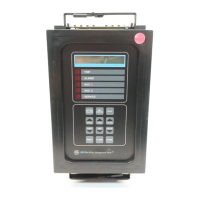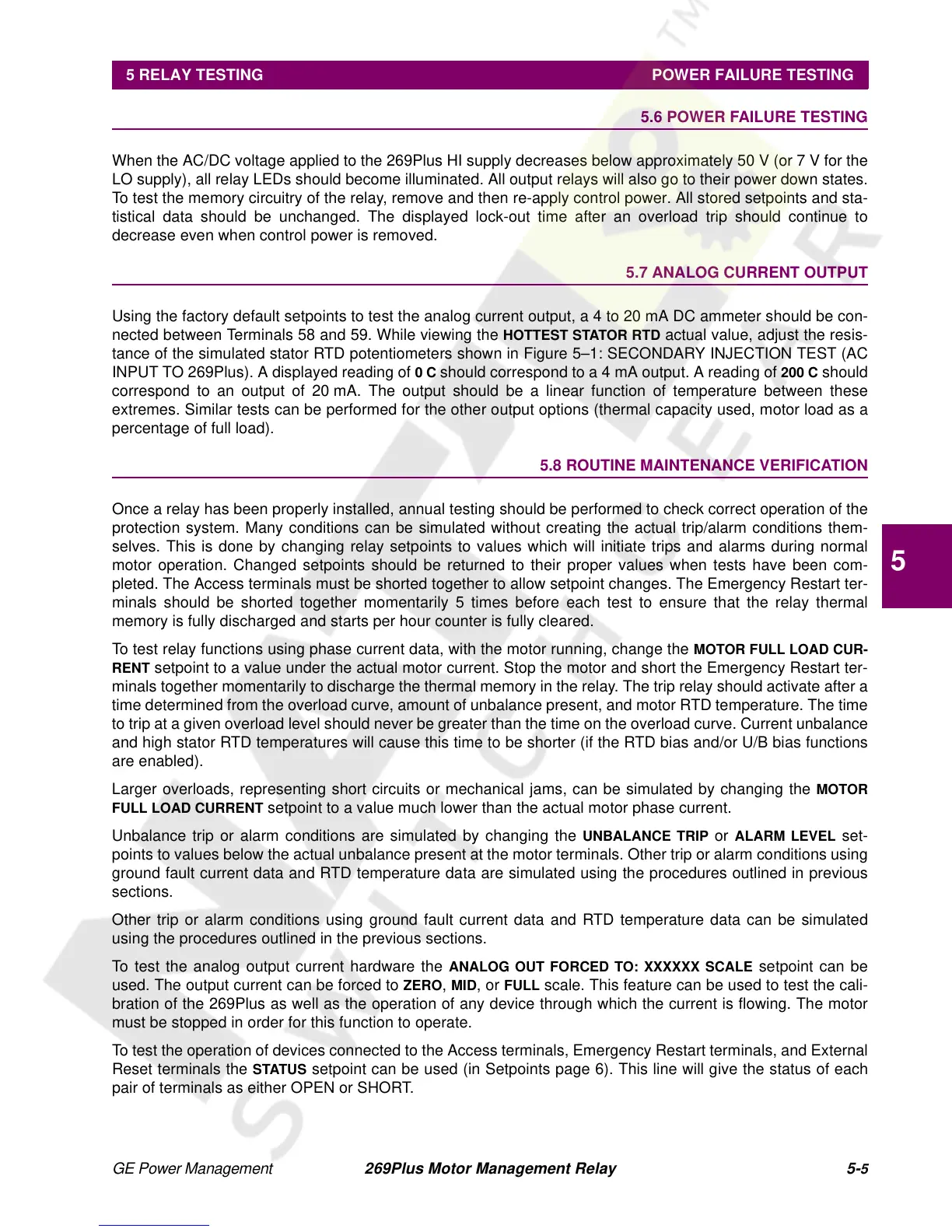GE Power Management 269Plus Motor Management Relay 5-
5
5 RELAY TESTING POWER FAILURE TESTING
5
5.6 POWER FAILURE TESTING
When the AC/DC voltage applied to the 269Plus HI supply decreases below approximately 50 V (or 7 V for the
LO supply), all relay LEDs should become illuminated. All output relays will also go to their power down states.
To test the memory circuitry of the relay, remove and then re-apply control power. All stored setpoints and sta-
tistical data should be unchanged. The displayed lock-out time after an overload trip should continue to
decrease even when control power is removed.
5.7 ANALOG CURRENT OUTPUT
Using the factory default setpoints to test the analog current output, a 4 to 20 mA DC ammeter should be con-
nected between Terminals 58 and 59. While viewing the
HOTTEST STATOR RTD actual value, adjust the resis-
tance of the simulated stator RTD potentiometers shown in Figure 5–1: SECONDARY INJECTION TEST (AC
INPUT TO 269Plus). A displayed reading of
0Cshouldcorrespondtoa4mAoutput.Areadingof200 C should
correspond to an output of 20 mA. The output should be a linear function of temperature between these
extremes. Similar tests can be performed for the other output options (thermal capacity used, motor load as a
percentage of full load).
5.8 ROUTINE MAINTENANCE VERIFICATION
Once a relay has been properly installed, annual testing should be performed to check correct operation of the
protection system. Many conditions can be simulated without creating the actual trip/alarm conditions them-
selves. This is done by changing relay setpoints to values which will initiate trips and alarms during normal
motor operation. Changed setpoints should be returned to their proper values when tests have been com-
pleted. The Access terminals must be shorted together to allow setpoint changes. The Emergency Restart ter-
minals should be shorted together momentarily 5 times before each test to ensure that the relay thermal
memory is fully discharged and starts per hour counter is fully cleared.
To test relay functions using phase current data, with the motor running, change the
MOTOR FULL LOAD CUR-
RENT
setpoint to a value under the actual motor current. Stop the motor and short the Emergency Restart ter-
minals together momentarily to discharge the thermal memory in the relay. The trip relay should activate after a
time determined from the overload curve, amount of unbalance present, and motor RTD temperature. The time
to trip at a given overload level should never be greater than the time on the overload curve. Current unbalance
and high stator RTD temperatures will cause this time to be shorter (if the RTD bias and/or U/B bias functions
are enabled).
Larger overloads, representing short circuits or mechanical jams, can be simulated by changing the
MOTOR
FULL LOAD CURRENT
setpoint to a value much lower than the actual motor phase current.
Unbalance trip or alarm conditions are simulated by changing the
UNBALANCE TRIP or ALARM LEVEL set-
points to values below the actual unbalance present at the motor terminals. Other trip or alarm conditions using
ground fault current data and RTD temperature data are simulated using the procedures outlined in previous
sections.
Other trip or alarm conditions using ground fault current data and RTD temperature data can be simulated
using the procedures outlined in the previous sections.
To test the analog output current hardware the
ANALOG OUT FORCED TO: XXXXXX SCALE setpoint can be
used. The output current can be forced to
ZERO, MID,orFULL scale. This feature can be used to test the cali-
bration of the 269Plus as well as the operation of any device through which the current is flowing. The motor
must be stopped in order for this function to operate.
To test the operation of devices connected to the Access terminals, Emergency Restart terminals, and External
Reset terminals the
STATUS setpointcanbeused(inSetpointspage6).Thislinewillgivethestatusofeach
pair of terminals as either OPEN or SHORT.

